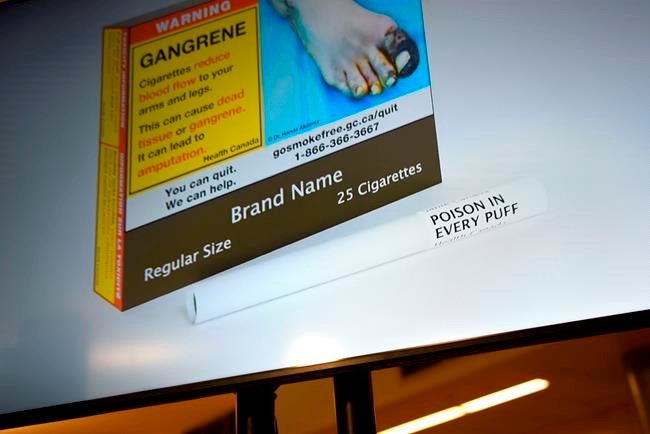MONTREAL — A fresh set of Health Canada regulations that will require warning labels on individual cigarettes is set to come into effect Tuesday.
The move, announced earlier this year, makes Canada the first country in the world to take that step in the ongoing effort to help smokers kick the habit and deter potential puffers from picking it up.
The wording that will eventually be on every cigarette, written in English and French on the paper around the filter, ranges from warnings about harming children and damaging organs to causing impotence and leukemia. "Poison in every puff," cautions one.
The labels will dissuade teens leaning toward taking up the habit and push nicotine-dependent parents looking to fight it, predicted Rob Cunningham, a senior policy analyst at the Canadian Cancer Society.
Once the regulations take effect, manufacturers have until the end of July 2024 to ensure the warnings are on all king-size cigarettes sold, followed by regular-size cigarettes and little cigars with tipping paper and tubes by the end of April 2025.
"For youth who experiment by 'borrowing' a cigarette from a friend, it's going to mean they will see the cigarettes — even if they may not see the package — where the warnings appear," Cunningham said in a telephone interview. "It's going to prompt discussion, including by smokers during smoke breaks: 'What warning have you got today?'
"Often it's kids who are urging their parents to quit, and this provides new information and messaging," Cunningham said.
Dozens of studies in Canada and elsewhere show the effectiveness of printing warnings on each cigarette, he noted.
Tobacco use continues to be one of Canada's most significant public health problems and remains the country's leading preventable cause of disease and premature death, then-health minister Jean-Yves Duclos said in a May 31 statement announcing the new warning labels.
About 15 to 20 per cent of patients with cancer are smokers at the time of diagnosis, with a higher percentage for certain types, such as lung cancer and head and neck cancers, said Dr. Lawson Eng, a medical oncologist at Toronto's Princess Margaret Cancer Centre and assistant professor in the University of Toronto’s department of medicine.
He couldn't say "for sure" that the messaging will reduce rates, but he noted that past efforts have succeeded in tandem with other public health measures, such as including cessation strategies in cancer screening and care.
"I suspect it will likely continue to help with decreasing smoking prevalence and also help with encouraging people who are smoking to try to quit," Eng said.
Tobacco advertising, promotion and sponsorship are banned in Canada, with warnings on cigarette packs dating back to 1972.
In 2001, Canada became the first country to require tobacco companies to print pictorial warnings on the outside of cigarette packages and include inserts with health-promoting messages.
More than 130 countries have followed suit, according to the Canadian Cancer Society.
Not all smokers view the escalating warnings favourably.
"I don't think that will really change much. A lot of people will continue to smoke," said Giovany Lincourt. "When I see a photo of a black lung, it hits me, but I still continue because it's a bad habit."
The 40-year-old Montrealer, who sampled his first cigarette at age 16, said still higher taxes would make a better deterrent. A pack of 25 typically costs between $11 and $16, depending on the brand and province.
"It hurts the wallet, because it costs $400, $500 a month," Lincourt said.
Blunt statements, including "Tobacco smoke harms children" and "Cigarettes cause cancer," will be among the first six messages. A second set of six is expected to be printed on cigarettes in 2026. Organizations funded by tobacco companies have opposed the push toward stronger messaging, including the latest step.
The National Coalition Against Contraband Tobacco warned in June that cheaper, colourful black-market packs free of health warnings — federal rules ban packaging that includes brand colours or trademarks — attract young smokers and funnel more money to organized crime.
Much of the coalition's funding comes from the Canadian Tobacco Manufacturers Council, made up of three of the biggest cigarette companies active in Canada: Rothmans, Benson & Hedges Inc., Imperial Tobacco Canada and JTI-Macdonald Corp.
While big tax hikes or outright sales bans would indeed benefit the black market, gradual price boosts and more strident messaging can bring down smoking rates, Cunningham said.
"The only real reason that they can oppose something is because it's going to have a reduction in sales — and that is exactly the point," he said of the manufacturers.
The Canadian Cancer Society and other advocacy groups are calling for a comprehensive strategy of beefed-up taxation, legislation and programming to bring down smoking rates — Health Canada's goal is less than five per cent of the 15-plus population by 2035 versus 13 per cent as of 2020. Price promotions and flavoured products — allowed in some provinces — should be banned, Cunningham said.
In May, the Canadian Cancer Society, the Canadian Lung Association and the Heart and Stroke Foundation published an open letter to premiers of all 10 provinces saying they should push for efforts to reduce smoking during settlement negotiations with three major tobacco companies that they sued years ago to recoup health-care costs.
Provinces are collectively seeking $500 billion in damages, and the three advocacy groups said at least 10 per cent of the money from a settlement should go toward smoking cessation efforts.
This report by The Canadian Press was first published July 31, 2023.
— With files from Camille Bains in Vancouver
Christopher Reynolds, The Canadian Press



